|
| | | |
A Colossal Enigma Adapted from an article Gian J. Quasar
Baal Bek is the name of an archeological site in Lebanon. In Roman times it was known as Heliopolis or City of the Sun. The holiest area (in pagan times) of the site was the Temple of Baal-Jupiter — a fusion of the ancient Canaanite god Baal (lord) and the Roman Jupiter, indicating a history of sacred use dating from long before the Roman domination of the region.
This temple complex was built over a period of several hundred years beginning before the birth of Christ and continuing until the second century, CE. It was built on a “tel” or ruin mound, indicating a place that had long been held sacred, though the origin of its "sacred" significance is unknown.
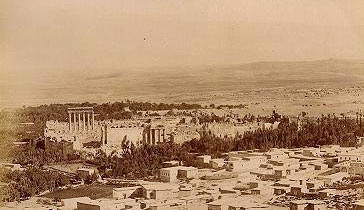
The ruins seen in the photo are the Roman temples of Bacchus (foreground) and Baal-Jupiter.
How old are the ruins?
Most date from Roman times. They, however, followed the pattern of building upon the “sacred” areas of cultures before them. This is also evident at Palmyra where the temple of Baal is also built upon a tel or ruin mound. The original Canaanite temples could be up to 2,000 years older than the Roman remains left today.
The question is, did the Canaanites do the same thing as the Romans did? In other words, did they build upon a preexisting, even more ancient site as well? If so, can we ascertain any clues as to why they held the site to be sacred?
The oldest parts of the ruins at Ball Bek are not built with the same techniques used by other, better known cultures like the Romans or Canaanites. This implies they were originally constructed by an unknown culture in an epoch long predating what we consider classical antiquity.
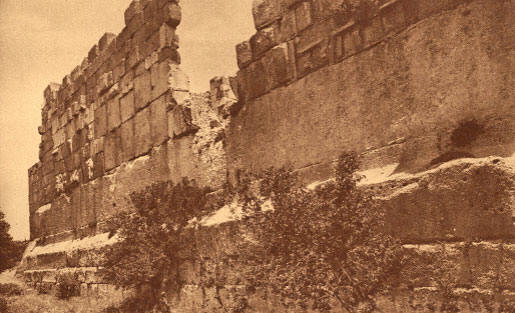 | Back of the temple of Baal-Jupiter.
Smaller stones from Roman buildings were re-purposed to form a medieval fortress placed haphazardly on top of the undisturbed megaliths . At the bottom of the picture, between the two trees, a man contemplates their size. Using the man for comparison, consider the size of the entire structure. The three megaliths (giant stone blocks) stand out as the massive layer below the later fortress constructed of relatively tiny blocks and above the layer of smaller (but still massive; in the 200 to 300 ton range) stones below.
|
The massive and elegant Roman stonework and columns pale by comparison to the megaliths they were built upon. The temple very visibly incorporates into its foundation, stones of some 1,500 tons. They are approximately 68 x 14 x 14 feet! They are the largest worked stones on earth! The extreme difficulty of moving these into place is hard to imagine even using modern engineering techniques. No other examples of Roman stonework in this style, scale, or method of excavation have ever been found, underlining the unique qualities of this site and the disconnect between the obviously Roman portions and the anomalous megaliths upon which they built.
| Adding to the mystery of the stones origin and intended use, these megaliths are not like the other “foundation stones” of the site, though "experts" declare them to be part of the Roman temple construction. The age, amount of erosion, and surface tool marks of the megaliths separate them from the structure built above them. The megaliths appear to be the top course of stones comprising some original edifice. Whatever its purpose, it was essential that the greatest stones had to be on top, not on the bottom. Rather than a foundation, these megaliths form the surface of the original structure, capping at least three tiers of much smaller (though still monumental) stones. | 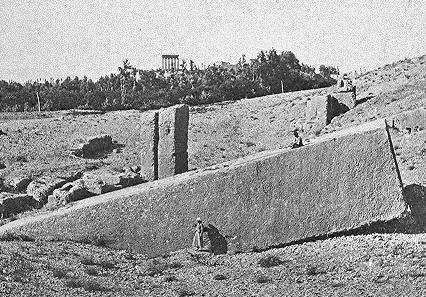 | | One stone left in the quarry, undressed yet. They are truly massive, perfect rectangles.This is the largest worked stone on earth. Some have estimated it to weigh up to 2,000 tons. | The base of the Roman temple does not match the megalithic platform. The Romans built the Temple of Jupiter so the rear wall was flush with three of the stones, but on one side the base of the temple does not coincide with the original megalithic structure, allowing a tier of megaliths to protrude obtrusively from the temple footprint — incongruously sloppy if they were intended simply as foundation stones for the Roman temple. If the Roman builders themselves had excavated the stones and gone to the tremendous effort of moving these megaliths wouldn't they have had the design and plans of the temple in mind? So why cut them long, which just adds to the weight and difficulty of transportation? But it seems the Romans built the temple to proportions that satisfied their own sacred and aesthetic purposes and did not bother to extend the building far enough to cover the layout of the megaliths. It is as though the Romans came upon an existing platform, a convenient and auspicious location upon which to build their temples. The megaliths of this ancient platform seem to be so different from the rest of the architecture as to throw much doubt on having been purpose-built for the Roman temple itself.  | What the original edifice must have looked like—a massive platform
| The excessive width of the megaliths compared to the stone wall above them is revealed on the far or backside of the temple. This view is the most famous in pictures because it shows the remarkable proportion of the megaliths in contrast to other stones around them. 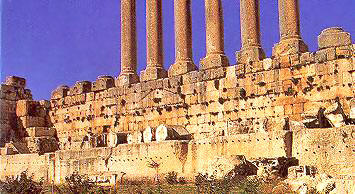 | | The great stones continue on this side as well, though their substructures are still buried. The Roman temple falls far short of these blocks, another indication they are not designed for the temple but predate it considerably. |
This wall is made up of many ill-fitted stones, many of them taken from the ruined Roman temple by the Arabs, Crusaders, and Turks when the stones were reassembled to be used as a fort. Some pieces of the Roman entablature can be seen, as well as slits cut into the rock for archers' use.
Because all these stones are piled one upon the other, it is clear to see a variety of stoneworking methods. The different methods used to make the larger square blocks suggest they predate the Roman era. These are huge stones, yet they are still dwarfed by the megalithic blocks below. 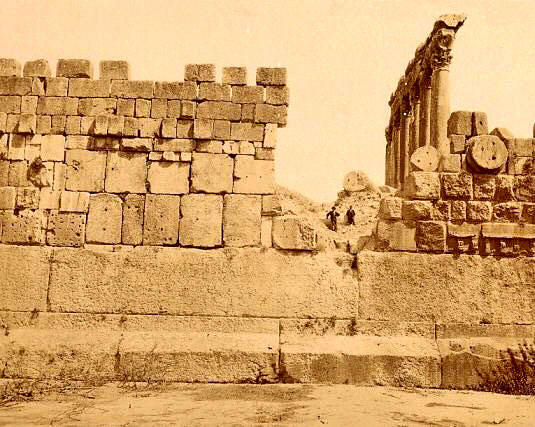
This extraordinary picture shows the famous backside of the temple. The stones of the ruined Roman temple were piled up to form a wall. There is even a column base. But see the huge stones next to the break in the wall. They are typical of an architecture called “Cyclopean,” a style that is the oldest we know of, yet the workmanship of the blocks appears crude and the scale modest when compared to the great megaliths below them. These Cyclopean stones do not appear to be Roman, yet were probably incorporated somewhere in the Roman temples. The medieval builders threw everything together without regard to make a fortress as quickly as possible, so now we see all eras displayed together. Look at how small the two men are compared to the Cyclopean stonework, let alone the megaliths upon which they are placed, and how they dwarf the more practically sized Roman building blocks.
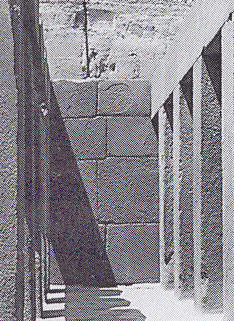 The Funerary Temple of Kafre at Giza,
4th dynasty (about 2500 BC).
Similar to the Cyclopean stonework seen above, noteworthy for economical cutting and fitting of imprecise angles in the blocks. Yet these are unlike the rectilinear precision seen in the great megaliths at Baal Bek.
The excavated walls of Kafre’s (Chefren) temple stands in the shadow of the second great pyramid at Giza, Egypt. Even this very ancient monumental wall seems younger than the megaliths at Ball Bek. The Egyptian stonework matches some of the Cyclopean, unattributed stonework found at Baal Bek. The techniques are so similar it can be inferred they were made by contemporaries of the Egyptians in what is now Lebanon or somewhat later by early Canaanites or other cultures lost to antiquity.
That Cyclopean style is similar to the monumental stonework of the earliest known cultures like the Egyptian, the pre-Inca Peruvian cultures, the prehistoric Maltese cultures, and similar to those found on the Bahamas Banks within the Triangle.
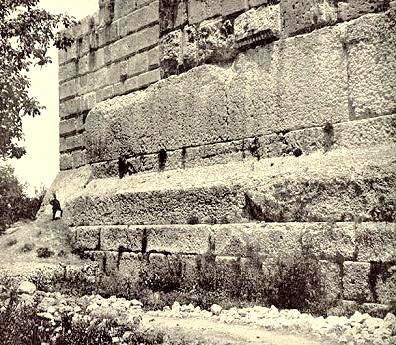
Excavating deeper, perfectly cut, though smaller, stones were found to support the megaliths. The megaliths were not designed as the foundation of the original edifice, but were meant to be on the top. Why? What for? The stones of the Roman temple can be seen built behind and on top of them.
This evolution in stonework is remarkable. From the small Roman and Turkish blocks, we go further down to monumental blocks identical with our earliest cultures. Yet lower than this, we come not to primitive mud bricks or shanty-hut foundations, but to the largest stones worked by man.
These are not clumsy artifacts, rough cut like Stonehenge. They are perfectly fitted 1,500 ton stones forming a unique structure.
Our own science and engineering today cannot explain the use stones that seem to exceed even Roman engineering capability, let alone determine their intended function. Was there an unknown ancient culture capable of cutting and moving these great stones, and placing them on top of others, in perfect fit and alignment, before the dawn of our most ancient recorded cultures? What caused them to pass away without leaving a clue as to who they were and to what purpose they built such a stupefying platform?
|
|
| |
|
|
|
| |
| |
|
|